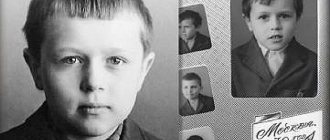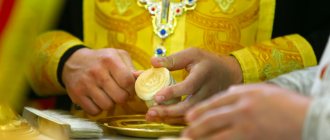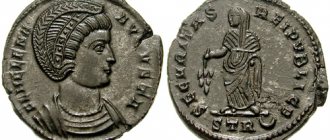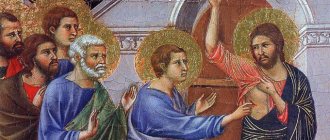The office of deacon was introduced for the first time in Judaism during the Second Temple.
The history of the deaconate began in Jerusalem, during the time of the Second Temple. At that time, each synagogue had three ministers. They were called parnasin, or in Hebrew, dispenser of mercy. He was also called gabai-edaka (collector of charity).
His duties also included caring for the poor. In addition, he must have had a good knowledge of the scriptures. In the Jerusalem church, which in the early period of the development of Christianity adopted the structure of the synagogue, there was the position of gabai-edak. She became the prototype of the Christian diaconal ministry.
Deacon Isaurian.
Fresco from the 11th century. It is believed that the rank of deacon first appeared in the Jerusalem Church. Photo: ic.pics.livejournal.com
As for the Christian Church itself, the first time in the Bible the word “deacon,” denoting a specific ministry, is found in Paul’s Epistle to the Philippians (Phil. 1:1), as well as in what was written a little later 1st Epistle to Timothy (1 Timothy (3:8).
Christian tradition says that the diaconal ministry arose in the early years of the emergence of the Jerusalem Church. As the Acts of the Apostles says (Acts 6:1-6), part of the Christian community complained about the uneven distribution of food and other supplies, as a result of which some of the widows were deprived.
Since the 4th century, deacons have been primarily engaged in liturgical functions.
The apostles themselves had to preach the word of God, so they did not have the opportunity to “tend for the tables.” For this purpose, by ordination they dedicated seven venerable persons chosen by the community to this ministry.
The Bible does not say anything about the office of deacon, since they retained the term “ministry (διακονία, diakonia) of the word.” That is why Holy Scripture does not call these seven deacons and indicates that their ministry consisted of fulfilling only one duty.
The first printed charter, published with the blessing of Patriarch Hermogenes by the printer Anisim Radishevsky at the Moscow Printing Yard in 1610.
The duties of deacons were first established in the Apostolic Church Rule. Photo: www.sb.by
“Apostolic Tradition” says that: “the duties of the deacon were to inform the bishop about all the sick, so that the bishop could visit them and commune the Holy Mysteries.”
Since the 4th century in the Christian Church, the diaconal ministry has brought liturgical functions to the fore. In VII, the 16th rule of the Trullo Council was adopted, according to which the ministry of deacons was to remain “a model of philanthropy and care for the needy” (τύπος φιλανθρωπίας καί σπουδής).
Secular clergy
The description of people who serve the Church and the Lord comes from the Old Testament. The scripture says that before the Nativity of Christ, the prophet Moses appointed people who were supposed to communicate with God. It is with these people that today's hierarchy of ranks is associated.
Altar server (novice)
This person is a lay assistant to the clergy. His responsibilities include:
- control over the safe and timely lighting of any candles and lamps;
- preparation of clothing and other symbols of clergy;
- timely offering of wine, prosphora and various attributes of church services;
- preparing the censer and lighting the fire in it;
- bringing a towel to wipe your lips during the sacrament of communion;
- putting things in order in the church.
If necessary, a novice can ring bells and read prayers, but he is strictly forbidden to touch the throne and walk between the altar and the Royal Doors. The altar server wears the most ordinary clothes, with a surplice thrown over the top.
Psalm Reader (Reader)
This person is not elevated to the rank of clergy. He must read prayers and words from scripture, interpret them to ordinary people and explain to children the basic rules of Christian life. For special zeal, the clergyman can ordain the psalmist as a subdeacon. As for church clothes, he is allowed to wear a cassock and a skufia (velvet cap).
Subdeacon
This person also does not have holy orders. But he can wear a surplice and an orarion. If the bishop blesses him, then the subdeacon can touch the throne and enter through the Royal Doors into the altar. Most often, the subdeacon helps the priest perform the service. He washes his hands during services and gives him the necessary items (tricirium, ripids).
During late Christianity, the duties of deacons became many and varied.
In the later Christian Church, the ministry of deacons began to include numerous duties and activities. So they began to observe the church deanery, namely:
- assign everyone a place at church services;
- monitor order in the temple and compliance with church canons;
- observe how believers behave and what their morals are, and report this to the bishop.
The deacons, according to the instructions of the bishop, managed church property, namely: they distributed alms, took care of the maintenance of orphans, widows and in general everyone who used church benefits.
Thus, they acted as intermediaries between the bishops and the flock: they conveyed the orders of the bishop to the flock and carried out his orders. That is why they were called the angels and prophets of the bishop.
7 people as deacons
In the ancient Church, deacons had great closeness to bishops, as well as a wide range of responsibilities. They were respected and participated in all church affairs. At the same time, many Churches, following the example of the Jerusalem Church, appointed no more than seven people to deacons.
Icon of the Venerable Julius the Presbyter and Julian the Deacon (5th century).
In order to remind the hierarchical ranks of clergy and the subordination of deacons to presbyters, the Ecumenical Councils have repeatedly issued corresponding decrees. Photo: tatmitropolia.ru
The influence of the deacons was much more significant than the influence of the elders, so some of the deacons treated them with contempt.
In order to stop this, Councils often adopted decrees in which they pointed out the lower hierarchical level of deacons compared to presbyters and their dependence on presbyters. In the Protestant Church, deacons are given importance in matters of Christian charity and in general in internal mission.
Prohibitions
As you know, church ministers have certain taboos in terms of their personal life. The rank of deacon is no exception. In his personal life, his words must correspond to his actions. Actions with good intentions. He must be absolutely devoted to his work and to the people who surround him. Also, he should not drink alcohol, gamble, or use substances that cause immediate addiction.
A deacon is a person who lives according to church commandments. He is obliged to perform only actions that do not contradict the words spoken in the commandments. A deacon is a person who lives according to his conscience. He will never allow himself to offend a person, insult him for some shortcoming, humiliate him in public, or commit an evil act. If he has a family, he should not have close relationships with other women.
He is obliged to love his children, to be a respectable father to them, and to his wife to be a faithful husband. Under no circumstances does he have the right to betray his wife or persuade her to take negative actions. Also, a person who wants to be ordained as a deacon must honor his parents. He needs to provide all possible assistance to solve their problems, help if possible, and engage in physical labor. Children need to be brought up strictly. Do not deprive absolutely everything, but also do not allow you to satisfy every whim and desire.
The position of deacons in the Russian Orthodox Church is the same as in ancient times
In the Orthodox Church, the hierarchical position of deacons has not changed since ancient times. Deacons are still considered assistants in the worship of priests and bishops. They do not independently perform public worship and cannot be representatives of the Christian community.
Precisely because priests have the right to perform all services and services themselves, in many churches deacons are not recognized as necessary and are therefore absent.
Dmitry Andreevich Tolstoy.
Portrait. I. Kramskoy. Chief Prosecutor of the Holy Governing Synod (June 23, 1865 - April 23, 1880). When Tolstoy was chief prosecutor of the Holy Governing Synod, he transferred the responsibility for maintaining deacons to the parishes. Photo: upload.wikimedia.org
During tsarist times, deacons at churches and parishes were also laid off. This was done in order to increase the salary of priests. So, for example, when the post of Chief Prosecutor of the Holy Synod was held by Count D.A. Tolstoy, at the request of parishioners, deacons were supplied from psalm-readers only in the event that the parish expressed a desire to support its own deacon. There were few rich parishes at that time and that is why the number of deacons was significantly reduced.
In the 1st-8th centuries, the rank of deaconess existed in the ancient Churches.
In the Russian Church, on official or solemn occasions it is customary to address the deacon: “Your gospel,” “Your thunder,” or “Your love for God,” despite the fact that such addresses are not indicated in the Church Protocol of the Russian Orthodox Church.
It should be noted that in the second half of the 20th century, the institution of a permanent diaconate was restored in the Catholic Church. The restoration of the permanent diaconate was formalized in 1967 by Pope Paul VI in the motu proprio Sacrum Diaconatus Ordinem.
Deacon of the Catholic Church of the Roman Rite.
In the second half of the 20th century, the institution of a permanent diaconate was restored in the Catholic Church. Photo: upload.wikimedia.org
In the 1st-8th centuries, in the ancient church there was a rank of female ministers who were called deaconesses, but they did not take part in the sacraments. This institution disappeared with the spread of female monasticism.
The ordination of women to the rank of deacon is widely practiced in Lutheranism. At the same time, at the beginning of the 20th century, the question of reviving the institution of deaconesses was also raised in the Russian Church. In 1911 they tried to open the first community of deaconesses in Moscow. The Local Council of the Russian Orthodox Church, held in 1917-1918, did not make any decision on this issue.
Underestimation of the role of the deacon during worship
It should be noted that during a church service, all the duties of a deacon can be performed directly by a priest or bishop. This sometimes causes the role of the deacon to be underestimated during the divine service. There are even known periods in the modern history of the church when there was a massive reduction in parish staff due to the abolition of this position in them. In the overwhelming majority of cases, this practice caused sharp discontent on the part of parishioners. There are frequent cases when a deacon, removed from the staff and thereby deprived of a salary, was taken into maintenance by the church community.
In Protestantism, deacons form the council of the church
Protestantism is a special movement in Christianity. This also manifests itself in relation to the institution of deacons. Thus, Protestants are of the opinion that the Church must take care of itself physically.
In addition, she must also take care of the poor. These responsibilities lie with deacons, although the Protestant Church never restored the idea of a New Testament deacon.
Training of deacons in the Presbyterian churches of Tula and the Tula region, the “Radiant” church.
The main task in Protestantism for a deacon is to ensure the physical existence of the church and bring the good news (preaching). Moreover, Protestant deacons are often not ordained. Photo: cs9782.vkontakte.ru
Nowadays, in some churches deacons are not ordained. Elsewhere, any ordained assistants in the Protestant church may be called deacons. They usually have the responsibilities of pastoral care and evangelism, that is, preaching.
Deacons are separate from and accountable to elders. In addition, in Protestantism, they assist the elders in conducting the Lord's Vespers, and also serve as the executive and financial council in those congregations where there is no council of elders.
Peculiarities
So, in this article, we looked at who a deacon is. They also answered the question of what his functions are and what character traits he should have. A deacon is a person who performs minor functions and has an indirect relationship with the sacraments occurring in the church. If a person shows his good side, he will be an example of morality and integrity; if he treats people kindly, supporting them in their sorrows and trusting them, he has every chance of increasing his rank and carrying out more significant assignments.
A deacon is not a monk and can marry for the first time
Many believers ask: how to become a deacon? A deacon is appointed before ordination from among the parishioners of the Orthodox Church, namely men whose age has not exceeded 25 years. If there are exceptions to this rule, they are very rare.
In the event that a candidate for the position of deacon has graduated from a theological seminary or college, this will be an additional advantage for him.
Deacon Andrey with his family.
Staged photo by A. Zhuk. A deacon is not a monk and may be getting married for the first time. Photo: ic.pics.livejournal.com
Sometimes they ask: can a future deacon get married or not? Here you need to know that unmarried people, first-married people, or widowers are ordained as deacons. So you can get married for the first time. In addition, a candidate for this ecclesiastical position must not have physical, spiritual or social impediments.
A deaf or blind person cannot serve as a deacon.
Obstacles of a physical nature are recognized only as those that could prevent him from performing priestly service, for example, a serious physical disability. That is why a deacon without an arm or leg can serve, but if he is blind or deaf, he cannot.
An obstacle of a spiritual nature is a weak faith or a desire to enter the priesthood under the influence of a serious mental illness. The desire to become a deacon must be conscious and deliberate, and the strength of faith must be proven not only in words, but also in deeds.
Requirements
We have looked at the answer to the question, what are the responsibilities of deacons in the church, and now let's try to figure out what requirements should be placed on him. A person who wants to serve in the church must be kind and sympathetic. He must do selfless and kind deeds. But you can’t shout about it to the whole world. Mercy should be shown simply like that, without expecting any praise or other reward.
This person must have great fortitude. As we know, clergy limit themselves to most worldly joys. The rank of deacon is no exception. Everyone who works in the church is obliged to observe fasts, pacify their passions, and not slander.
An indispensable condition is faith in God. A deacon is a person who sincerely believes in the divine principle. He calls with his actions and deeds to such an understanding of the world and other people.
In a church setting, it must be approved by other superiors. To ordain deacons, clergy read a prayer. After pronouncing it, the deacon can begin his duties.
How to become a deacon: ordination during the Liturgy after the consecration of the Holy Gifts
Before a candidate is ordained as a deacon, the protege is required to pass a test, that is, he will be required to undergo a protege confession before the diocesan confessor for his entire life and the priestly oath.
Next, the confessor tells the bishop whether the protege is ready to be ordained or not. It is worth noting that the confession of a future deacon can be either secret or general. Photos of the protege’s confession procedure can be easily found on the Internet and you can see with your own eyes how it goes
Ordination of Vitaly Ulyanov as deacon. At 1 minute 27 seconds the actual procedure for ordination to the deacon begins. This happens during the Liturgy after the consecration of the Holy Gifts.
If the protege is admitted to ordination, then the process of ordination itself occurs during the Liturgy after the consecration of the Holy Gifts. The ordination of a deacon is performed by the local bishop or bishop.
To do this, the protege is led three times around the Altar (the table located in the middle of the altar to celebrate communion (Eucharist) on it. During this, the protege kisses its corners.
After this, he kneels before the Throne and places his head on it. Next, the bishop or bishop puts a special ribbon on his head, the honor of his vestment, which is called an omophorion, and, having read a special prayer, lays his hands on the omophorion).
Black clergy
It includes only those who have taken monastic vows. This hierarchy of ranks is more detailed than that of those who preferred family life to monastic life.
Hierodeacon and Archdeacon
This is a monk who is a deacon. He helps clergy conduct sacraments and perform services. For example, he carries out the vessels necessary for rituals or makes prayer requests. The most senior hierodeacon is called “archdeacon.”
Hieromonk
This is a man who is a priest. He is allowed to perform various sacred sacraments. This rank can be received by priests from the white clergy who decided to become monks, and by those who have undergone consecration (giving a person the right to perform the sacraments).
Hegumen (abbess)
This is the abbot or abbess of a Russian Orthodox monastery or temple. Previously, most often, this rank was given as a reward for services to the Russian Orthodox Church. But since 2011, the patriarch decided to grant this rank to any abbot of the monastery. During initiation, the abbot is given a staff with which he must walk around his domain.
Archimandrite
This is one of the highest ranks in Orthodoxy. Upon receiving it, the clergyman is also awarded a miter. The archimandrite wears a black monastic robe, which distinguishes him from other monks by the fact that he has red tablets on him. If, in addition, the archimandrite is the rector of any temple or monastery, he has the right to carry a rod - a staff. He is supposed to be addressed as “Your Reverence.”
Bishop (overseeing)
This rank belongs to the category of bishops. At their ordination, they received the highest grace of the Lord and therefore can perform any sacred rites, even ordain deacons. According to church laws, they have equal rights; the archbishop is considered the most senior. According to ancient tradition, only a bishop can bless the service with an antimis. This is a quadrangular scarf in which part of the relics of a saint is sewn.
This clergyman also controls and guards all monasteries and churches that are located on the territory of his diocese. The generally accepted address to a bishop is “Vladyka” or “Your Eminence.”
Metropolitan
This is a high-ranking clergy or the highest title of bishop, the oldest on earth. He obeys only the patriarch. Differs from other dignitaries in the following details in clothing:
- has a blue robe (bishops have red ones);
- The hood is white with a cross trimmed with precious stones (the rest have a black hood).
This rank is given for very high merits and is a badge of distinction.
Patriarch
The highest rank in the Orthodox Church, the main priest of the country. The word itself combines two roots: “father” and “power”. He is elected at the Council of Bishops. This rank is for life; only in the rarest cases is it possible to depose it and excommunicate it. When the place of the patriarch is empty, a locum tenens is appointed as a temporary executor, who does everything that the patriarch should do.
This position carries responsibility not only for itself, but also for the entire Orthodox people of the country.
The ranks in the Orthodox Church, in ascending order, have their own clear hierarchy. Despite the fact that we call many clergy “father,” every Orthodox Christian should know the main differences between dignitaries and positions.
Sources:
https://www.syl.ru/article/325967/dyakon—eto-kto https://dic.academic.ru/dic.nsf/ruwiki/909178 https://religiya.temaretik.com/1186658890762422306/chiny- v-pravoslavnoj-tserkvi-po-vozrastaniyu-ih-ierarhiya/
The deacon is obliged to perform all those duties that the priest does not perform
Since the deacon is the priest’s assistant, he is obliged to carry out all his instructions. That is why in church literature the deacon is compared to an angelic order, which is called upon to help the Lord God himself.
Deacons help families who find themselves in difficult life situations, keep church equipment and church property in good condition, clean the premises before and after services, assist in organizing funerals, etc.
Sermon by Deacon Roman Bezmenov. At 3 seconds the author begins the sermon, since the deacon can do this without much objection.
Sometimes believers ask: can a deacon preach? In the Russian Orthodox Church, a deacon can preach the Gospel without any permission if he has a gift from the Lord to do so. In addition, the deacon has other rights:
- Be a member of the Church Council without being elected.
- Conduct conversations with members of the church community.
- combine the diaconal ministry with the ministry of a regent or conductor
- Organize material services in the church, etc.
Cases when a deacon serves for more than 3-4 years are rare, so they are usually ordained priests.
In any case, the deacon has no right to replace the priest. At the same time, along with him, during worship he can touch sacred vessels. Street notes that there is a practice of ordaining deacons as priests, which is associated with the need to renew the clergy. That is why deacons usually serve only briefly, although in the history of the Russian Orthodox Church there are cases when people served in this rank for 10 years or more.
By leaving a comment, you accept the user agreement
Diaconate that is misunderstood
Having shared with you the view of Scripture on the ministry of diakonia, I now want to present erroneous views that I have found in our churches. And you will already clearly see what their infidelity and even danger are.
Deacon – the grise eminence of the church
I have heard the following saying in the world: “He who has the wallet is in charge.” Therefore, pastors sometimes control all the finances of the church. But this should not be the case in the Body of Christ.
In a healthy church, finances are collected and accounted for by deacons. They distribute them for the affairs and needs of the church. At membership meetings they regularly give an account down to the last penny. But this does not mean at all that deacons lead the community and have the final say on financial matters.
The finances and material resources of the church are also the sphere of spiritual leadership, the sphere of pastoring. Money and equipment are given to the church for no other purpose than to invest in two areas: the spiritual development of church members and their evangelism to the world. These are the core values, and pastors determine that this is where funds should be spent.
But sometimes deacons become directors who determine what the church will and will not do. And instead of helping the church grow spiritually or evangelize, deacons act like business executives who need to ask permission. They dominate people, manipulate them, turn into gray cardinals - and, without thinking about the purpose of the church, they hinder its development.
Our deacons know better than I the flow of funds in our community and sometimes say that we do not yet have funds for some projects. But instead of prohibiting, refusing and slowing down initiatives because there is no money and people, wise deacons are moved by faith: they call on God for help, look for opportunities, develop strategies for increasing resources, and discuss with the church how to achieve God’s goals.
Silent Deacon
This, I would say, is the other extreme: a deacon who is always in the role of a younger brother. Traditionally, in our churches, all authority is given to the elders, and deacons are perceived as their assistants. Although biblically this is not so: both elders and deacons are one strong team of employees.
I have also seen fatalistic deacons in communities whose credo is: “I’m a small man, if they say so, I’ll do it.” They themselves try not to offer anything in particular, silently waiting for them to be told what they need. Like apprentices in the wings. They may be good performers, but that's not what diaconal ministry looks like. After all, a deacon is a leader who cares about the entire community. He looks for opportunities for its development, cares for people, takes initiative because he loves the church.
Deacon in transit
Another mistake: thinking that the diaconate is a step on the path to the pastorate. I call this a “temporary deacon.” He is in this service, as it were, in transit. He needs it to gain attention and move to a “higher level.”
This mistake has even become part of the tradition of our churches: before being ordained to the pastoral ministry, a brother is first ordained to the deaconate. I don’t know, maybe they did this for humility, to test their brother in practical work. But the result was not good - the diaconal ministry was no longer perceived as important and worthwhile.
Diaconate and pastorate are not career steps, but two completely independent ministries, different areas of giftedness and callings for life.











